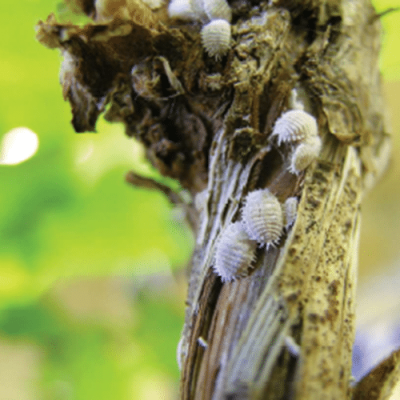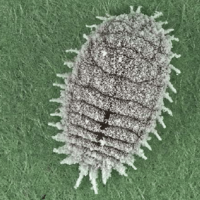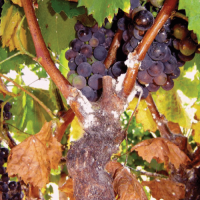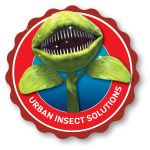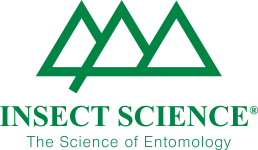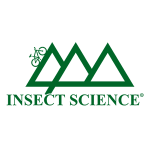Host plants
Planococcus ficus is polyphagous, having been recorded from hosts belonging to about 20 plant families. Host plants in its native range include various families, such as Vitaceae (grapevines), Moraceae (cultivated fig), Salicaceae (willows), Rosaceae (apple) and Punicaceae (pomegranate).
Damage
Grapevine mealybug is a key pest on grapevines in South Africa, particularly as it is the vector of grapevine leafroll virus. Mealybugs have syringe-like mouthparts which they insert into the phloem tissue of grapevines to suck the sap. They feed on the trunks (illustrated), branches, shoots and leaves, and the bunch of stems and berries of grape bunches (illustrated). In high numbers this can cause browning and wilting of leaves, desiccation of bunches, loss of nutrients, and can result in premature leaf drop. Repeated serious infestations weaken grapevines and can result in the death of individual vines. Mealybugs also excrete sticky honeydew on which sooty mould fungus grows. Table grape bunches infested with mealybugs, honeydew or sooty mould are unfit for human consumption and are rejected for marketing. Infested wine grape bunches can be downgraded at cellars. As the primary vector of grapevine leafroll virus, grapevine mealybug plays a key role in the spread of grapevine leafroll, a debilitating disease resulting in serious economic losses.
Life history
Eggs are laid in sacs consisting of a mass of wax threads. Crawlers hatch after 7-10 days at an average temperature of 25 °C, and this is the stage that actively disperses. The life cycle of female and male grapevine mealybugs differ substantially. Crawlers destined to become flightless females moult three times, the third moult being to the adult female. After mating and a protracted pre-oviposition period, the female starts laying eggs into an egg sac. Each female can lay up to 750 eggs in a lifetime, which ranges from several weeks to several months.
Crawlers destined to become males moult into second instar nymphs. Each nymph spins a cocoon in which the third instar nymph, pre-pupa and pupa develop. Adult winged males then emerge from the cocoon. They have no feeding mouthparts, and live for 1-3 days; their only purpose is to mate. In summer, mealybugs can complete their lifecycle in 3-4 weeks, resulting in rapid population explosions.
All life stages can be present throughout the year. In winter, mealybugs shelter beneath loose bark and in cracks on the trunks of vines. Mealybugs can also hibernate on grapevine roots and weeds. During winter, the mealybugs continue to feed on vine sap and even lay eggs, but development is very slow. As soon as temperatures start rising in spring and early summer, crawlers emerge in search of new growth with higher nutrient content. Crawlers settle on new leaf and shoot growth, where they continue to develop, mate and multiply. Populations are at their highest in January and February. Mealybugs then move onto the bunches where the nutrient levels are increasing, feeding mainly on bunch and berry stems. In late summer and autumn nutrients move from leaves and stems to the roots, and the mealybugs begin to migrate downward. There can be 3-7 generations per year.
Natural enemies
Various indigenous and introduced natural enemies control grapevine mealybug and some can even be obtained from commercial insectaries. Introduced parasitic wasps include the encyrtids Leptomsdtix dactylopii Howard, Leptomastidea abnormais (Girault), Coccidoxenoides peregrinus Girault (available commercially) and Chrysoplatycerus splendens (Howard) (introduced against pear and apple mealybug). Other natural enemies include the indigenous encyritid Pseudococcobuis vinealis Prinsloo and Anagyrus sp. near pseudococci, which also occurs in Mediterranean countries. Predatory ladybird beetles include Nephus sp. (an indigenous species), Cryptolaemus montrouzieri Mulsant (available commercially), Hippodamia variegate (Goeza), and indigenous Exochomus spp. Other generalist predators such as lacewing larvae (Chrysoperla spp.) also contribute to the natural control of mealybugs in vineyards.
Management
As the primary vector of grapevine leafroll virus, grapevine mealybug should be monitored regularly throughout the growing season. Visual inspections of vines should be done regularly to determine if ants and/or mealybugs are present. Pheromone traps baited with the sex pheromone of the female vine mealybug can also be used in conjunction with visual inspections. When visual inspection shows less than 2% of grapevines infested, natural enemies can be purchased and released to control mealybug, provided that ants are controlled. Ant control should commence if visual inspection shows that 20% of the vines are infested with ants.
Overwintering mealybugs can be controlled by applying a suitable insecticide to dormant grapevines shortly before budding. Outbreaks during the growing season can be controlled with cover sprays, if the withholding period of the insecticide permits. Alternatively, spot sprays of only infested vines can be applied to the soil in spring to control agents which otherwise could keep mealybug populations below economic levels. In South African vineyards, the presence of Linepithema humile (Mayr), Anoplolepis custodiens (Smith), A. steringroeveri (Forel), Crematogaster peringueyi Emery and Technomyrmex albipes (Smith) can render the augmentative release of parasitic wasps ineffective. Ant control is therefore crucial in vineyards. Chemicals to control ants should be applied only to the main stems of the vines, using a ring spray attachment that will apply the chemical right around the stem. This creates a barrier preventing ants from moving into the vine canopy.

